Daniel Sherrier's Blog, page 23
November 26, 2016
Today’s Super Comics — Power Man and Iron Fist #1-4 (2016)
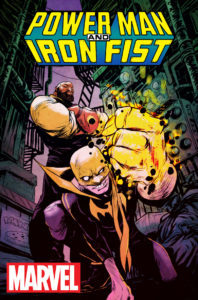 I initially overlooked this series. Judging from the first storyline, that was a mistake.
I initially overlooked this series. Judging from the first storyline, that was a mistake.
Power Man and Iron Fist manages to be consistently amusing while maintaining a strong heart at its core. Ultimately, it’s a series about friendship—that of the two title characters, and that of the two antagonists, one of which also happens to be a longtime friend and colleague of Luke Cage and Danny Rand.
The dynamic between Luke and Danny is as great as you’d expect for two characters with a lengthy history. Danny wants to renew their old partnership. Luke does not. Jessica Jones especially does not (she and Luke have been married for some time in the comics; here, she’s just a recurring cameo, but even her brief appearances are always welcome). Also great is how the heroes’ error in judgment sets the plot into motion.
I hadn’t realized that Mariah Dillard, Alfre Woodard’s character on the Luke Cage Netflix series, had a comic book counterpart, one who apparently answers to the name “Black Mariah” (yeah, that sounds a bit dated). The two versions of the character have practically nothing in common, other than both being criminals. Still, the comic book version works well in this medium and this story (nickname aside).
I’ll be sure to check out #5 when it hits Marvel Unlimited.
Writer: David Walker
Artist: Sanford Greene
Publisher: Marvel Comics
How to Read It: recent back issues; Marvel Unlimited; Comixology; included in Power Man and Iron Fist vol. 1: The Boys Are Back in Town (TPB)
Appropriate For: ages 12 and up
November 25, 2016
Today’s Super Comic — Supergirl #34 (1999)
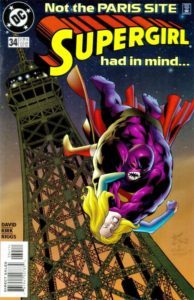 The problem with having two identities is sometimes they need to be on different continents at the same time.
The problem with having two identities is sometimes they need to be on different continents at the same time.
The fun continues in Supergirl #34, which gives us not only secret-identity hijinks, but also a classic Superman villain, a cameo by some young super-whippersnappers, and major progress and a major setback for Linda’s professional life.
The issue kicks off on a creepy note, as a trail of desiccated rats leads law enforcement to the voracious Parasite, and then it’s on to art. Linda’s sculptures are debuting in a Parisian venue, which gives us a welcome reminder that Linda isn’t just a vessel for Supergirl—she’s got her own goals and interests that have nothing to do with superheroing. Unfortunately, however, Supergirl is also scheduled to give a speech in the U.S. at the same time. Hijinks ensue, along with the Parasite.
This particular incarnation of the Parasite serves as a nice counterbalance to this particular incarnation of Supergirl, as he also has absorbed someone else’s consciousness into his own. Between the two of them, they’re enough people to form a club.
Fun times indeed. I’m still enjoying rereading this series, though I certainly would not recommend starting in the middle.
Writer: Peter David
Penciler: Leonard Kirk
Inker: Robin Riggs
Publisher: DC Comics
How to Read It: back issues; Comixology
Appropriate For: ages 11 and up
November 24, 2016
More than halfway!
Back in May, I decided it would be a swell idea to review one comic book a day for a year. Earlier this month, I hit the halfway point, and I somehow haven’t given up on it.
For those of you just tuning in, I’m writing only positive reviews to highlight the good stuff. (There’s enough negativity elsewhere.) I think of it as a lengthy thank-you to an industry that has provided me with countless hours of enjoyment since I was eight years old. Some books I’ve read many times over the years, some I’m reading for the first time, and some I hadn’t read in well over a decade.
It’s not a “best of” list. The books appear in no particular order, and I’ll end up excluding many great ones. It’s just whatever I happen to be reading or whatever old favorite I feel like sharing that particular day. Usually I’ll focus on just one issue, but occasionally I’ll highlight a full storyline or miniseries all at once. There really is no grand plan at work here. You never know quite what to expect as you check in each day…and I usually don’t either.
Maybe you’ll find some good recommendations to try out, or maybe you’ll just be reminiscing along with me. Perhaps a bit of both. Any which way, I hope you enjoy.
And I apologize for the very unpolished prose. The pace leaves little time for revision, and I am still hard at work on my novel, Terrific, in which I’ll contribute my own superheroes to the literary world. (That will be polished.)
That book is coming. In the meantime, check out the many excellent comics I’ve highlighted.
Today’s Super Comics — Daredevil #183-184 (1982)
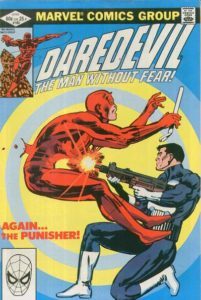 I’ve never been a Punisher fan. He’s a killer, not a hero. Maybe I could get behind him if he was on a redemption arc, kind of like how Wolverine strives to tame his inner animal and be a better man. But no, the Punisher strikes me as simply an unhinged murderer who thinks he’s doing the right thing…which makes him a great antagonist for vigilantes who are actually heroic, such as Daredevil.
I’ve never been a Punisher fan. He’s a killer, not a hero. Maybe I could get behind him if he was on a redemption arc, kind of like how Wolverine strives to tame his inner animal and be a better man. But no, the Punisher strikes me as simply an unhinged murderer who thinks he’s doing the right thing…which makes him a great antagonist for vigilantes who are actually heroic, such as Daredevil.
Daredevil and Punisher come into conflict in Daredevil #183 and 184, near the end of Frank Miller’s series-redefining run. Matt Murdock’s mature ethics are on full display as he defends a criminal in court because he believes the man to be innocent of the current charges. Meanwhile, Punisher just wants to shoot up all them bad guys. And Daredevil’s not having it.
The Daredevil/Punisher conflict was the strongest part of Daredevil season two on Netflix, and these comics give us a very early version of it. It’s more streamlined in comic book form, but still greatly compelling.
Though I continue to have zero interest in a solo Punisher series.
Writers: Frank Miller and Roger McKenzie
Artists: Frank Miller and Klaus Janson
Publisher: Marvel Comics
How to Read It: back issues; Marvel Unlimited; Comixology; included in Daredevil Visionaries: Frank Miller vol. 3 (TPB)
Appropriate For: ages 12 and up
November 23, 2016
Today’s Super Comics — Iron Man #17-18 (1969)
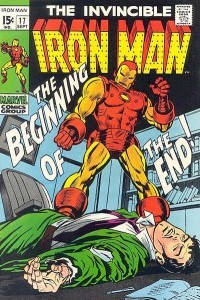 Iron Man takes on a classic sci-fi trope—the invention rising up to replace the inventor. This wouldn’t be the last time Tony Stark’s technology causes trouble, but it’s the first time it happened in an exciting story that holds up pretty well compared to its contemporaries, thanks to the exceptional writing of Archie Goodwin, one of the all-time greats of the industry.
Iron Man takes on a classic sci-fi trope—the invention rising up to replace the inventor. This wouldn’t be the last time Tony Stark’s technology causes trouble, but it’s the first time it happened in an exciting story that holds up pretty well compared to its contemporaries, thanks to the exceptional writing of Archie Goodwin, one of the all-time greats of the industry.
In an earlier issue, Tony made use of a Life Model Decoy (LMD) to help preserve his secret identity, but a freak accident causes the robot to come to life…and this time, it possesses the ambition to become both Tony Stark and Iron Man in the eyes of the world. It has his exact looks, all his knowledge, and none of his heart troubles, and it easily convinces people that the real Stark is actually the imposter. And in order to get his life back, Stark has to resort to working with new villain Madame Masque.
These two issues culminate in an Iron Man vs. Iron Man battle, with Tony donning his original, less sophisticated armor to fight the tireless LMD. And the victory is not without a cost.
Goodwin puts Tony through hell, and in doing so, he gives us one of the highlights of the late ‘60s.
Writer: Archie Goodwin
Penciler: George Tuska
Inker: Johnny Craig
Publisher: Marvel Comics
How to Read It: back issues; Marvel Unlimited; Comixology; included in Essential Iron Man vol. 3 (TPB)
Appropriate For: ages 9 and up
November 22, 2016
Today’s Super Comic — The Astonishing Ant-Man #8 (2016)
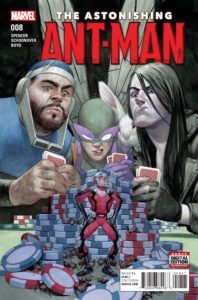 The fun continues in The Astonishing Ant-Man #8, this time with a colorful bunch of henchmen playing poker while sharing the tips of the trade with a newbie.
The fun continues in The Astonishing Ant-Man #8, this time with a colorful bunch of henchmen playing poker while sharing the tips of the trade with a newbie.
Don’t work for Nazis, laugh at Spider-Man’s jokes, pay your taxes—the henchmen dispense such wisdom throughout a book that’s clearly not taking itself seriously (always a healthy approach, I’d say). But the silly humor never detracts from the central father/daughter conflict that continues to build.
The payoff will come later, but I remain interested in seeing how it plays out. And I remain impressed at how well writer Nick Spencer balances the comedy and drama. A good time all around.
Writer: Nick Spencer
Artist: Brent Schoonover
Cover: Julian Totino Tedesco
Publisher: Marvel Comics
How to Read It: recent back issues; Marvel Unlimited; Comixology; included in The Astonishing Ant-Man vol. 2: Small-Time Criminal (TPB)
Appropriate For: ages 12 and up
November 21, 2016
Today’s Super Comic — Buffy the Vampire Slayer: Season Eight #16 (2008)
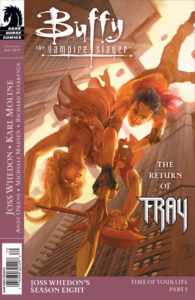 All Buffy comic books will pale in comparison to the TV show—my favorite show of all time. But that doesn’t mean the comics can’t be fun in their own right.
All Buffy comic books will pale in comparison to the TV show—my favorite show of all time. But that doesn’t mean the comics can’t be fun in their own right.
Buffy the Vampire Slayer: Season Eight continues where the TV show left off, and it continues with storylines and plot elements that would have looked stupidly ridiculous on live-action television, such as a giant Dawn early in the series and a flying Buffy later on. This is Buffy without the budgetary restrictions, but it works just fine in comic book form because the characters all sound like themselves and act true to form under the guidance of series creator Joss Whedon. And artist Karl Moline does a superb job translating the actors into cartoons.
One of the stronger storylines begins in #16, and it benefits from reintroducing us to characters and a setting created specifically for comic books.
Buffy time-travels to the future and meets Fray, who was the protagonist of Whedon’s spinoff miniseries of the same name. With this being only part one, we just get a taste of how these two leading ladies will interact, and it’s already spot-on.
This series isn’t an essential continuation of the TV show, but it scratches the itch for us diehard fans. (Though I still haven’t gotten around to reading Season Nine. One of these days.)
Writer: Joss Whedon
Penciler: Karl Moline
Inker: Andy Owens
Cover: Jo Chen
Publisher: Dark Horse Comics
How to Read It: back issues; Comixology; included in Buffy the Vampire Slayer vol. 4: Time of Your Life (TPB)
Appropriate For: ages 13 and up
November 20, 2016
Today’s Super Comic — Marvel Adventures: The Avengers #13 (2007)
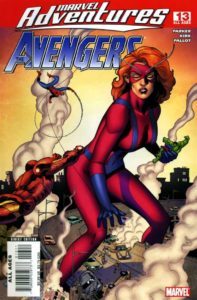 I’m always happy to see when the major comic book publishers remember that children might want to read comics, too. About a decade ago, Marvel launched its all-ages Marvel Adventures line with that thought in mind. These stories were set outside Marvel’s main (and increasingly convoluted) continuity. They were simpler, cleaner, and more accessible to anyone of any age picking up any random issue.
I’m always happy to see when the major comic book publishers remember that children might want to read comics, too. About a decade ago, Marvel launched its all-ages Marvel Adventures line with that thought in mind. These stories were set outside Marvel’s main (and increasingly convoluted) continuity. They were simpler, cleaner, and more accessible to anyone of any age picking up any random issue.
These Avengers were some of the company’s most recognizable characters—Captain America, Iron Man, Spider-Man, Hulk, and even Storm and Wolverine from the X-Men. And they stuck closely to their original molds. No major reinterpretations here, just faithful adherence to each character’s core essence. With one big exception.
In Marvel Adventures, Janet Van Dyne did not become the incredible shrinking Wasp. She instead grew into the role of Giant-Girl, which was a very smart decision on Marvel’s part.
Issue #13 reveals Giant-Girl’s origin, and does so with good humor and nice inversions of classic tropes. No dark past or death of a loved one motivates Janet to help others. Rather, the fact that helping others is the right thing to do motivates her. And when Dr. Henry Pym presents her with size-changing technology and suggests shrinking to insect-size, she discovers a more practical application.
So we’ve got a great role model in a story that’s good, clean fun. There’s not much for adults, but it’s a comic you can give your kids without reservation.
Writer: Jeff Parker
Penciler: Leonard Kirk
Inker: Terry Pallot
Publisher: Marvel Comics
How to Read It: back issues; Marvel Unlimited; included in Marvel Adventures: The Avengers vol. 4: The Dream Team (TPB)
Appropriate For: ages 7 and up
November 19, 2016
Today’s Super Comics — Plastic Man #8-9 (2004)
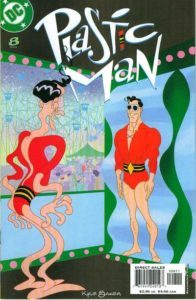 Plastic Man is an utterly ridiculous character. Any comic about him should be likewise. And that’s exactly what cartoonist Kyle Baker delivered in his Plastic Man series.
Plastic Man is an utterly ridiculous character. Any comic about him should be likewise. And that’s exactly what cartoonist Kyle Baker delivered in his Plastic Man series.
I call Baker a cartoonist rather than writer/artist because this book is pure cartoon, full of farce, visual gags, a total lack of realism, and in the case of #8 and #9, some amusing commentary on comic book continuity.
Specifically, Plastic Man’s ex-wife and illegitimate son show up—and Plas has no recollection of them. But they were indeed part of established continuity. See, for a few years before this, Plastic Man chiefly served as the comic-relief character in JLA, but along came an ill-advised plotline that cast him in the role of a deadbeat dad (even good series seldom bat a thousand). So Baker addresses it here with wacky time-travel shenanigans…and poking lots of fun:
“I risk my life daily for the good of humanity, I’ve battled armies of space aliens to save the earth! Are you telling me I wouldn’t take care of my own child if I had one? That doesn’t make any sense!”
“I don’t know, Dad. I think it makes you complex.”
“Only if by complex you mean ‘multiple personality disorder.’”
Naturally, this all leads to Plastic Man and his associates trying to assassinate Abraham Lincoln.
Utterly ridiculous…in exactly the right way.
Cartoonist: Kyle Baker
Publisher: DC Comics
How to Read It: back issues; Comixology; included in Plastic Man vol. 2: Rubber Bandits (TPB)
Appropriate For: ages 11 and up
November 18, 2016
Today’s Super Comic — Doctor Strange #1 (1974)
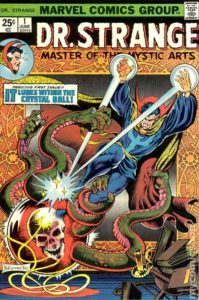 Doctor Strange the movie was excellent, but admittedly I haven’t read much of his solo comic book adventures. Thanks to the magic of Marvel Unlimited, I can rectify that.
Doctor Strange the movie was excellent, but admittedly I haven’t read much of his solo comic book adventures. Thanks to the magic of Marvel Unlimited, I can rectify that.
Marvel has attempted a Doctor Strange series multiple times since the character debuted in the ‘60s, and perhaps the longest-running series was the one that began in 1974. Steve Englehart wrote the earliest issues, and his presence is always a good sign—he was one of the strongest comic writers in the ‘70s, and his work on Doctor Strange #1 is every bit as solid as I expected. I’m less familiar with artist Frank Brunner, but his fluid style, with lots a wispy lines and dark undercurrents, captures exactly the right feel for Marvel’s premier sorcerer.
Englehart wisely avoids rehashing the origin story that’s already been told. Instead, the series kicks off with an assassination attempt on Doctor Strange in his own home, the capture of his apprentice/girlfriend Clea, and his absorption into a mystical orb, where he meets a twisted version of literature’s most famous caterpillar.
It’s all an intriguing start, and I might need to keep reading.
Writer: Steve Englehart
Artist: Frank Brunner
Publisher: Marvel Comics
How to Read It: back issues; Marvel Unlimited; Comixology; Essential Doctor Strange vol. 3 (TPB)
Appropriate For: ages 11 and up



